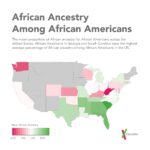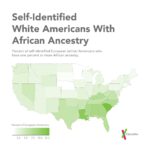In a new study published in the 
Regional Ancestry Differences
The study offers a detailed look at how the ancestry make-up of self-identified African Americans, Latinos and European Americans differs by region and these differences reflect some of the distinctive socio-political history in different parts of the United States.
“Our study not only reveals the historical underpinnings of regional differences in genetic ancestry, but also sheds light on inconsistencies between genetic patterns and commonly accepted notions of race and ethnicity,” Kasia said.
DNA USA
Although the study doesn’t pretend to be a comprehensive portrait of the genetic makeup of the United States, it’s unprecedented in its scope and it does show how the history of the Americas as a crossroad for disparate cultures is written in our DNA.
Using aggregated and anonymous data from 160,000 23andMe customers who consented to research, Kasia looked at how the ancestral make-up for whites, blacks and Latinos differed in each state. Some of what she found is well known, but some of the data illuminates a United States with a much more complicated multicultural history than many of us understand.
Hidden African Ancestry
Among her findings were that about 3.5 percent of self-identified European Americans have at least 1 percent or more African Ancestry. It’s likely that many of these Americans, who describe themselves as white, may be unaware of their African ancestry, which in many cases goes back between five to ten generations. There are also differences regionally – with the highest levels in the South – so that in South Carolina, at least 13 percent of self-identified whites have 1 percent or more African ancestry, while in Louisiana the number is a little more than 12 percent.
In Georgia and Alabama the number is about 9 percent. The differences perhaps point to different social and cultural histories within the South.
Among black Americans, those with the highest percentage of African ancestry also live in southern states, especially South Carolina and Georgia. The percentage of the population who are African Americans are also highest in those states, but there are also differences among states with similar percentages of African Americans.
Native American Ancestry
That may also be due to the different histories of those states. Kasia’s study also found that one in every 20 African Americans have Native American ancestry, while in Oklahoma 14 percent of African Americans carry at least two percent Native American ancestry.
Among self-reported Latinos in the US, those from states in the southwest, especially from states bordering Mexico, have the highest levels of Native American ancestry.
But among Latinos too there were wide regional differences that also likely reflect the history of migration and intermixing. For example, some Latinos have no discernible Native American ancestry, while others have as much as 50 percent of their ancestry being Native American. Latinos in states in the Southwest, bordering Mexico – New Mexico, Texas, California and Arizona – have the greatest percentage of Native American ancestry. Latinos in states with the largest proportion of African Americans in their population – South Carolina, Louisiana and Alabama – have the highest percentage of African Ancestry.
All three groups — African Americans, European Americans and Latinos — showed asymmetrical male and female ancestry contributions, with more European male and more Native American and African female ancestors. This asymmetry is likely a legacy of slavery, unbalanced sex ratios in frontier settings, as well other social factors.

